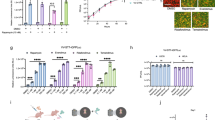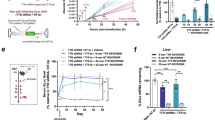Abstract
Cytomegalovirus (CMV) promoter is often present in recombinant adenovirus vectors (AdVs) suitable for gene therapy, ensuring high levels of transgene production in a wide range of hosts. Despite this characteristic, the presence of the AdV genome in target cells and tissues typically lasts longer than transgene production that may be rapidly extincted by ill-defined silencing mechanisms. In the present article, it is reported that transcriptionally active drugs, retinoic acid (RA) and histone deacetylase inhibitor trichostatin A (TSA), enhance AdV transgene expression in infected cells and tissues. The association of RA and TSA increased more than seven-fold above control the activity of AdVs encoding for LacZ or VEGF165. This effect was, at least in part, mediated by the direct activation of retinoic acid receptors. Finally, administration of RA and TSA alone at days 0 and 5 after infection prolonged transgene production up to 21 days after infection versus 6–8 days in untreated controls. These results indicate that transcriptionally active drugs improve AdV function and may represent a novel strategy to more efficiently design AdVs for gene therapy interventions.
This is a preview of subscription content, access via your institution
Access options
Subscribe to this journal
Receive 12 print issues and online access
$259.00 per year
only $21.58 per issue
Buy this article
- Purchase on Springer Link
- Instant access to full article PDF
Prices may be subject to local taxes which are calculated during checkout





Similar content being viewed by others
References
Kajon AE, Brown CC, Spindler KR . Distribution of mouse adenovirus type 1 in intraperitoneally and intranasally infected adult outbred mice J Virol 1998 72: 1219–1223
DeMatteo RP et al. Cellular immunity delimits adenoviral gene therapy strategies for the treatment of neoplastic diseases Ann Surg Oncol 1999 6: 88–94
Lihui Qin et al. Promoter attenuation in gene therapy: interferon-γ and tumor necrosis factor-α inhibit transgene expression Hum Gene Ther 1997 8: 2019–2029
Boshart M et al. A very strong enhancer is located upstream of an immediate early gene of human cytomegalovirus Cell 1985 41: 521–530
Rotondaro L, Mele A, Rovera G . Efficiency of different viral promoters in directing gene expression in mammalian cells: effect of 3′-untranslated sequences Gene 1996 168: 195–198
Guo ZS, Wang LH, Eisensmith RC, Woo SL . Evaluation of promoter strength for hepatic gene expression in vivo following adenovirus-mediated gene transfer Gene Therapy 1996 3: 802–810
Wade EJ, Klucher KM, Spector DH . An AP-1 binding site is the predominant cis-acting regulatory element in the 1.2-kilobase early RNA promoter of human cytomegalovirus J Virol 1992 66: 2407–2417
Rideg K et al. DNA-binding proteins that interact with the 19-base pair (CRE-like) element from the HCMV major immediate early promoter in differentiating human embryonal carcinoma cells Differentiation 1994 56: 119–129
Gribaudo G et al. Interferon-alpha inhibits the murine cytomegalovirus immediate-early gene expression by down-regulating NF-kappa B activity Virology 1995 211: 251–260
Loser P, Jennings GS, Strauss M, Sandig V . Reactivation of the previously silenced cytomegalovirus major immediate–early promoter in the mouse liver: involvement of NFkappaB J Virol 1998 72: 180–190
Ghazal P et al. Retinoic acid receptors initiate induction of the cytomegalovirus enhancer in embryonal cells Proc Natl Acad Sci USA 1992 89: 7630–7634
Angulo A, Suto C, Heyman RA, Ghazal P . Characterization of the sequences of the human cytomegalovirus enhancer that mediate differential regulation by natural and synthetic retinoids Mol Endocrinol 1996 10: 781–793
Kornberg RD, Lorch Y . Chromatin-modifying and remodeling complexes Curr Opin Genet Dev 1999 9: 148–151
Xu L, Glass CK, Rosenfeld MG . Coactivator and corepressor complexes in nuclear receptor function Curr Opin Genet Dev 1999 9: 140–147
Kuo MH, Allis CD . Roles of histone acetyltransferases and deacetylases in gene regulation Bioessays 1998 20: 615–626
Mirza MA, Weber J . Structure of adenovirus chromatin Biochim Biophys Acta 1982 696: 76–86
Fedor MJ, Daniell E . Acetylation of histone-like proteins of adenovirus type 5 J Virol 1980 35: 637–643
Dion LD et al. Amplification of recombinant adenoviral transgene products occurs by inhibition of histone deacetylase Virology 1997 231: 201–209
Ng HH, Bird A . DNA methylation and chromatin modification Curr Opin Genet Dev 1999 9: 158–163
Belmont AS et al. Large-scale chromatin structure and function Curr Opin Cell Biol 1999 11: 307–311
Beato M . Chromatin structure and the regulation of gene expression: remodeling at the MMTV promoter J Mol Med 1996 74: 711–724
Tenenbaum L et al. Cellular contaminants of adeno-associated virus vector stocks can enhance transduction Gene Therapy 1999 6: 1045–1053
Minucci S, Pelicci PG . Retinoid receptors in health and disease: co-regulators and the chromatin connection Semin Cell Dev Biol 1999 10: 215–225
Nelson EJ, Kay MA . Persistence of recombinant adenovirus in vivo is not dependent on vector DNA replication J Virol 1997 71: 8902–8907
Mühlhauser J et al. Safety and efficacy of in vivo gene transfer into the porcine heart with replication-deficient, recombinant adenovirus vectors Gene Therapy 1996 3: 145–153
Mühlhauser J et al. VEGF165 expressed by a replication-deficient recombinant adenovirus vector induces angiogenesis in vivo Circ Res 1995 77: 1077–1086
Sterpetti AV et al. Shear stress increases the release of interleukin-1 and interleukin-6 by aortic endothelial cells Surgery 1993 114: 911–914
Acknowledgements
This work has been partially supported by grants from the European Union (Biomed96 1160, Biomed97 2270), Telethon (A61) and AIRC. The authors would like to thank Professor Frank Graham for encouragement and helpful discussion of results during the progress of this work. Special thanks to Mrs Gabriella Ricci and Miss Cinzia Carloni for help in typing and editing of this manuscript.
Author information
Authors and Affiliations
Rights and permissions
About this article
Cite this article
Gaetano, C., Catalano, A., Palumbo, R. et al. Transcriptionally active drugs improve adenovirus vector performance in vitro and in vivo. Gene Ther 7, 1624–1630 (2000). https://doi.org/10.1038/sj.gt.3301296
Received:
Accepted:
Published:
Issue Date:
DOI: https://doi.org/10.1038/sj.gt.3301296
Keywords
This article is cited by
-
Differential Type I Interferon-dependent Transgene Silencing of Helper-dependent Adenoviral vs. Adeno-associated Viral Vectors In Vivo
Molecular Therapy (2013)
-
Repeat Administration of Proteins to the Eye With a Single Intraocular Injection of an Adenovirus Vector
Molecular Therapy (2008)
-
HDAC inhibitor valproic acid upregulates CAR in vitro and in vivo
Genetic Vaccines and Therapy (2007)
-
Sustained expression after nonviral ocular gene transfer using mammalian promoters
Gene Therapy (2006)
-
Angiogenesis is confined to the transient period of VEGF expression that follows adenoviral gene delivery to ischemic muscle
Gene Therapy (2005)



